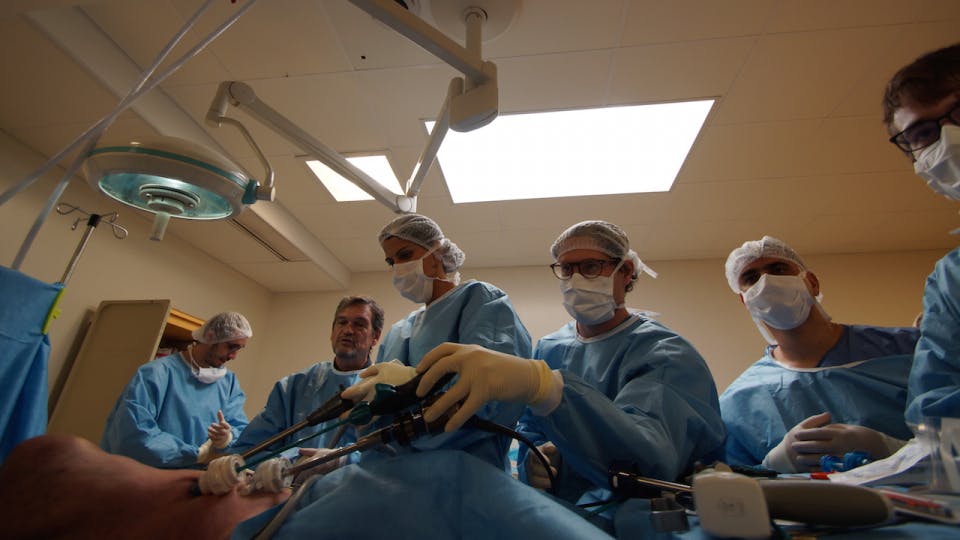INVIVOX : Can you tell us about ABS Lab?
Dr Denis ORIOT : ABS Lab, is an anatomy, biomechanics and simulation laboratory. We participate in the international INSPIRE network to create tools for paediatric simulation. We are at the origin of the "SimLife net" network, designed to create scenarios and evaluation scales in surgical simulation based on the "SimLife" model.
INVIVOX : « SimLife » is an ABS Lab development, can tell us about this internationally-unique concept?
Dr D. O. : These are bodies given to science that are reperfused pulsatively and returned with a technical module attached and connected, so that they can best simulate a surgical procedure in the operating room. Pumps (circulatory and respiratory) improve the consistency and colour of the organs and allow the vessels to beat and bleed upon incision, as if it were an anaesthetized patient. It is the most advanced support in surgical simulation.
NVIVOX : Which tools do you use in simulation training?
Dr D. O. : We use the most realistic models possible in an environment that is, similarly, as close to reality as possible. We create a learning environment as close to clinical reality as possible with highly realistic scenarios, allowing participants to fully adhere to the simulated situation; meaning by tacit contract. It’s in this very precise environment that we will be able to measure performance and find the correlation between performance in simulated conditions and actual clinical performance. From there we can draw conclusions such that performance in simulation is 95% representative of clinical performance. Without this tacit contract and without making the effort to be as realistic as possible, the correlation between the simulated and clinical situations would be impossible.
INVIVOX : Which models will you work on?
Dr D. O. : All models are used either on site, or by transposition to other sites, or from remote locations, such as e-learning. There are many of them : electronic models teaching software with a specific algorithm to treat a simulated patient within the software, simulated or standardized patient models (people trained to play a role without any room for manoeuvre, whether actual patients recruited at the hospital or even actors brought in to stage a simulation such as the announcement of bad news or the announcement of an event associated with care etc.). The vast majority of the models we use are whole body mannequins (ranging from newborn to adult to pregnant woman). They can be low fidelity (inactive, i.e. they cannot breathe alone, there is no pulse) and high fidelity (active with integrated and remote technology by bluetooth or wifi that allows them to speak, move, breathe, turn blue, with an active pulse). We also have mannequins, usually in low fidelity, which are procedural models (plastic model body segments with more or less feedback). We also have other models that are used on animal tissues to learn stitches, intraosseous routes, etc.
"« Training with simulation, it’s like a serious game. »"
INVIVOX : Who are the “Designing an evaluation and research project in simulation-based training” and “How to run a debriefing in simulation-based training” courses aimed at?
Dr D. O. : These two courses are intended for people who already have simulation experience, even if it is not very significant (from several months to about a year), but who seriously want to become a simulation trainer and develop the use of simulation.
INVIVOX : In “Designing an evaluation and research project in simulation-based training”, which methods are you teaching?
Dr D. O. : This training provides all the tools necessary to evaluate a simulation training and assess all the essential tools to perform a simulation as well. It will allow participants to get to know the validation process and the creation of an evaluation scale, which are two crucial elements to deliver a simulation program. During the training we will work on different (tailor-made) models according to the expectations of participants who probably want to set up a research and development program in simulation or set up a training that will become a research program. If they want to work on communication, they will work with simulated patients. If they want to work on a life-saving emergency, they will work with a model. If they want to work, for example, on peripheral perfusion, it will be on a procedural model with an infusion arm. Participants come without a way to develop their program, and they leave with a complete training research project and with all the evaluation tools they could need.
INVIVOX : What is the Kirkpatrick Pyramid?
Dr D. O. : It’s the essential pyramid when approaching research, training and evaluation in simulation. It’s a model of evaluating teaching processes. It’s important to integrate the four levels of the pyramid. The genius of Donald Kirkpatrick is having started with level 1, which is that of trainees and finishing at level 4 which is that of patients. Often trainees have heard of Kirkpatrick but don’t know how to use the model.
""We cannot have a learning curve where there is an area of high economic and ethical risk. During this learning curve, we can operate in simulation, on models, and obtain an increase in performance as we repeat again and again. Once the trainee reaches 95% of the expected performance, they come to a point of translation and are then authorized to operate on a real patient. »"
INVIVOX : What is the objective of the “How to run a debriefing in simulation-based training” masterclass ?
Dr D. O. : When there is training, there is a trainer and a trainee. After the training, the simulation, the trainer watches the trainee perform. Obviously, the trainer has an idea of the ideal performance that should have been achieved and the actual performance that was achieved. So there is a discrepancy (no discrepancy would mean that the team has learned nothing). We only learn from our mistakes. How can we make this discrepancy a source of learning? By the delivery of a verbal message between the trainer and the trainee; it is at the moment of this message being delivered that the transfer, i. e. the acquisition of knowledge, can be made. The debriefing following the simulation is very important. Without a debriefing, there is no learning. Depending on the quality of the debriefing, there may or may not be a learning process. There can be destructive or constructive debriefings. The objective of this training is to teach a communication technique to people who are destined to be trainers in simulation, so that they can carry out the best debriefings possible.
INVIVOX : What are the benefits for trainees ?
Dr D. O. : For the first training course, on evaluation and research in simulation, the two key points are:
- An extensive knowledge of evaluation; in teaching the processes, the models and the evaluation scales used.
- The ability to develop a research project in simulation.
For the second training course, on debriefing, the three key points are:
- To understand the structure of a debriefing which isn’t improvised (with strictly standardised language).
- To use communication methods adapted to having a clear and inoffensive debriefing.
- To experiment in a practical and repeated way.

